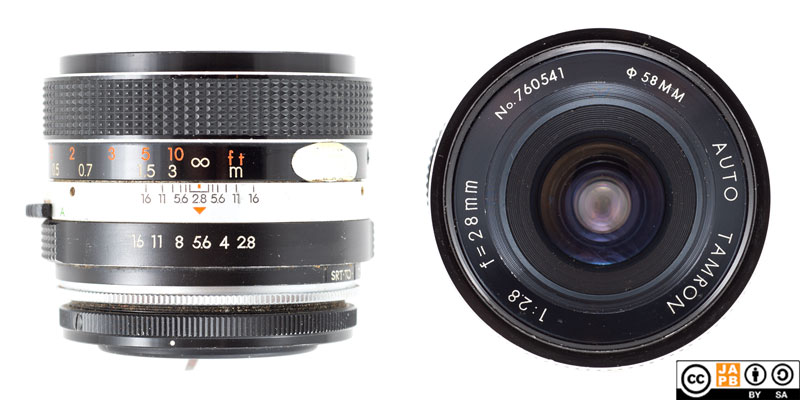Pekka Buttler, 07/2025

Specifications
The table below summarises the lens’ key specifications (measurements based on pictured sample with Canon FD adapter):
| Brand: | Tamron | Lens name | Auto 1:2.8 f=28mm |
| Focal length(s) 1 | 28 mm | Angle-of-view 2 | 75° |
| Maximum Aperture | f/2.8 | In Production | 1972-73 |
| Lens mounts (native) | Tamron Adapt-a-matic | Other lens mounts | See Adapt-a-matic article |
| Length 3 | 56,7 mm | Diameter 4 | 67,5 mm |
| Filter ring diameter | 58 mm | Weight | 280 grams |
| Lens element count | 7 | Lens group count | 7 |
| Aperture blades (S/R/C) 5 | 5 S | Focus throw | 180 ° |
| Minimum focusing distance (measured) | 24 cms | Maximum magnification (measured) | 1:5,5 |
| Has manual aperture ring | YES | Has manual focus ring | YES |
| Aperture mechanism type | Automatic | Aperture click stops (on preset ring) 6 | 2.8•4•5.6•8•11–16 |
Further notes:
• This is a wide-angle lens manufactured for the Tamron Adapt-a-matic mount.
Versions
There are at least four different versions of the Auto Tamron 28 mm f/2.8 with the adapt-a-matic mount:
– versions 1 and 2 are significantly longer (59 mm or more, including adapter ring) and have a 62 mm filter thread while versions 3 and 4 are shorter (58 mm or shorter, including adapter ring) and have a 58 mm filter ring.
– Versions 1 through 4 all feature a 7 elements in 7 groups design, but apparently the lens’ optics was redesigned between versions 2 and 3.
– Version 1 is the only one to feature a metal focus ring, version 4 is the only one to have detents on the aperture ring to enable aperture ring coupling (which was however never implemented on the adapt-a-matic mount).
Adapting
Given that this lens uses an intermediate mount, there are several ways to go, depending on what your intention is
To film SLRs or dSLRs?
You’re in luck, because there used to be Adapt-a-matic adapters made for pretty much every mainstream SLR system available before the mid-70s, (including at least7: Canon FD, Exakta, Konica AR, M42, Minolta SR, Miranda, Nikon F, Olympus OM, Pentax K, Petri FT). What you need to do is head to your favourite online classifieds platform and procure an adapter (adapters for dSLR mounts are still available new).
To Mirrorless
Again, not a challenge. If you do not yet have a Adapt-a-matic adapter to an SLR mount, you can buy any combination of an Adapt-a-matic to SLR and SLR to mirrorless adapter.
History of Tamron
A short history of Tamron can be found as part of the Tamron company profile.
Footnotes
- Focal length is (unless stated otherwise) given in absolute terms, and not in Full-frame equivalent. For an understanding of whether the lens is wide/tele, see ‘Angle-of-view’. ↩︎
- Picture angle is given in degrees and concerns the diagonal picture angle. Rule of thumb:
> 90 ° ==> Ultra-wide-angle
70–90 ° ==> Wide-angle
50–70 ° ==> Moderate wide-angle
40–50 ° ==> ‘Standard’ or ‘normal’ lens
20–40 ° ==> Short tele lens
10-20 ° ==> Tele lens
5-10 ° ==> Long tele lens
< 5 ° ==> Ultra-tele lens ↩︎ - Length is given from the mount flange to the front of lens at infinity. ↩︎
- Diameter excludes protrusions such as rabbit ears or stop-down levers. ↩︎
- S=straight; R=rounded; C=(almost)circular at all apertures. ↩︎
- Numbers equal aperture values on aperture ring; • intermediate click; – no intermediate click. ↩︎
- This list will only contain adapters that we at JAPB have witnessed. ↩︎